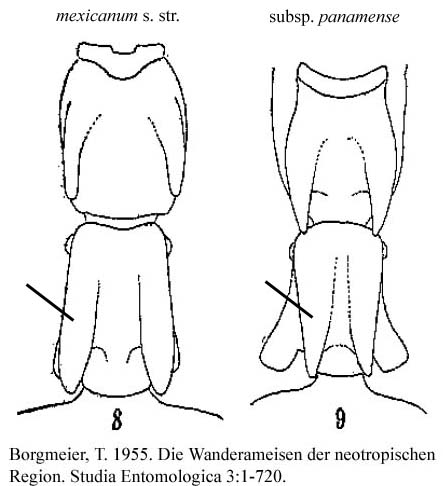Ecitoninae, Formicidae, Hymenoptera, Insecta, Arthropoda, Animalia
Additional images: male, line drawing of face from Watkins (1976) (click here).
Range
Mexico (type locality) to northern Argentina. Costa Rica: throughout.
Identification
Minor worker: head and mesosoma maroon, metasoma somewhat lighter yellow brown; occipital tooth present; petiolar teeth fused, forming a bilobed scoop-like structure, with a single median carina extending down the posterior face of propodeum; petiole long and low, subrectangular, occasionally with a low anterodorsal rim; fourth abdominal tergite with short, sparse appressed pubescence beneath erect setae.
Major worker: face densely micropunctate, matte; long sickle-shaped mandibles simple, without tooth on inner margin; other characters as in minor.
Natural History
This species can be found in dry forest or wet forest, from sea level to montane areas.
Raiding is always in columns, never in a carpet like E. burchellii. Many of the raiding columns I have observed have been at night, showing a tendency to be nocturnal, but I also encounter columns during the day. The few times I have encountered prey they have been large ponerines in the genera Ectatomma and Pachycondyla.
Comments
Borgmeier (1955) described a subspecies panamense from central Panama, based on workers and queen. He differentiated panamense from mexicanum s. str. as follows (my translation): "The soldier differs from mexicanum s. str. by the shorter scapes (1.84mm), shorter funiculus, shorter mandible (3mm) and smaller postpetiole (0.56mm broad posteriorly), and by a well developed anteroventral petiolar tooth (also present on the available minor workers, while it is missing or very short on the workers of mexicanum s. str.)." His key to the queens differentiated the forms as follows:
Petiolar horns with approximately parallel sides, dorsal longitudinal sulcus broad and deep: mexicanum s. str.
Petiolar horns tapered posteriorly, dorsal longitudinal sulcus narrow and shallow: panamense

The degree of development of the anteroventral petiolar tooth is highly variable among the Costa Rica material I have examined, from nearly absent to well developed. I consider panamense a junior synonym of mexicanum until evidence to the contrary.
Page author:
John T. Longino, The Evergreen State College, Olympia WA 98505 USA.longinoj@evergreen.edu